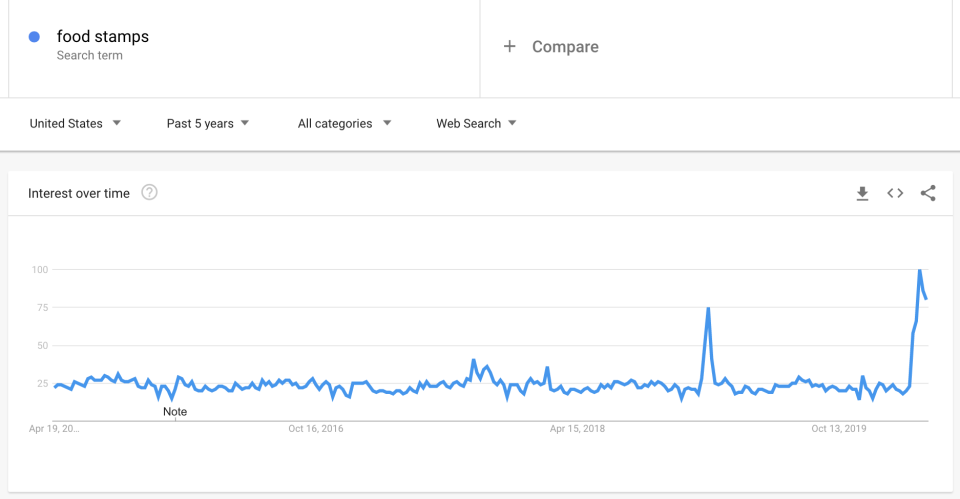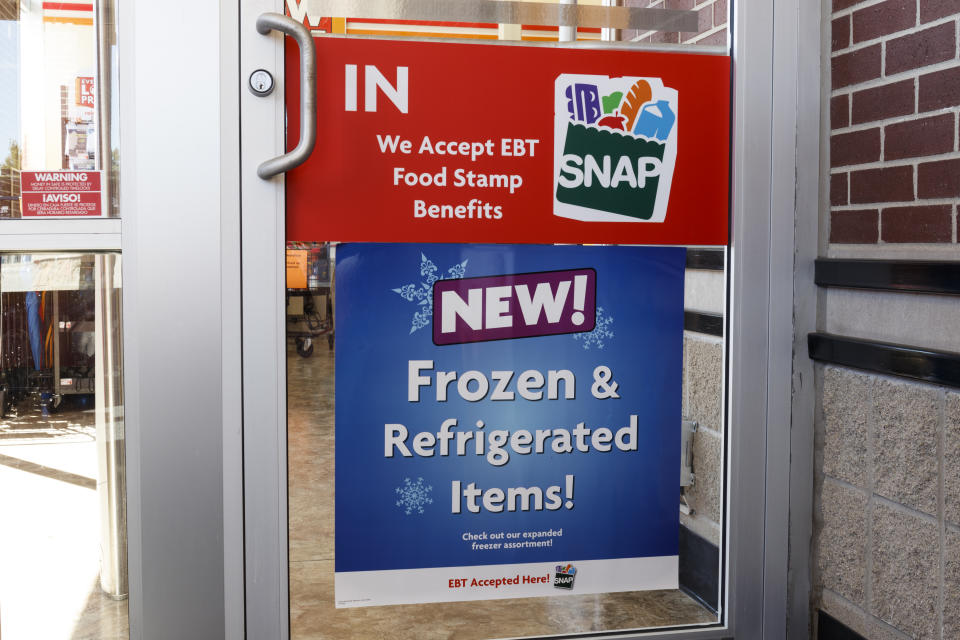‘Never applied before’: Americans are signing up for food stamps in droves
A surge of Americans are asking the government to help them buy the most basic necessity — food — as the coronavirus pandemic wreaks havoc on their financial security.
Applications for the Supplemental Nutrition Assistance Program (SNAP), the federal program formerly known as food stamps that provides monetary benefits for grocery staples, is skyrocketing, according to data Yahoo Money obtained from six states.
Read more: Coronavirus: How to apply for food stamps
California and Texas reported 48% and 102% year-over-year increases in applications in March, while Nevada and Rhode Island applications jumped 23% and 77% when comparing the two previous 30-day periods. New York and Louisiana saw their weekly average for applications double and sextuple in mid-March.
The Google search term “food stamps” also spiked to its highest volume level in the last five years, with the only other uptick occurring in January 2019 during the longest federal government shutdown. The onslaught of new applications has prompted some state agencies to beef up staffing.

“We’ve received over 100,000 applications since the COVID-19 crisis began on March 16,” said Marketa Garner Walters, secretary of the Louisiana Department of Children and Family Services, which is bringing in additional staffers. “Many of our neighbors are applying for SNAP who have never applied before.”
The data further underscores the financial desperation for many Americans who’ve been hurt by the unprecedented efforts to stem the outbreak that has shuttered schools, businesses, and much of public life for weeks.
‘Challenging time for many Americans’
SNAP is federally funded and run by the U.S. Department of Agriculture, but individual state agencies manage each program. Unlike unemployment claims, federal nutrition assistance programs numbers aren’t tracked and reported weekly.
So, where national jobless claims have publicly surged, SNAP applications have quietly followed.

“USDA is maximizing our services and flexibilities to ensure children and others who need food can get it during this coronavirus epidemic,” said USDA Secretary Sonny Perdue in a statement provided to Yahoo Money. “This is a challenging time for many Americans.”
Read more: How to file for Medicaid if you lose your job
The most recent data supplied by the USDA shows that the total number of SNAP participants was on the decline before the pandemic, falling 8.7% to 37.1 million in January from 40.6 million in the same month in 2019. However, a source at the USDA confirmed that many states are seeing similar recent increases that the data Yahoo Money obtained show.
State by state
California: In March, 230,000 residents applied for CalFresh, the state’s version of SNAP, up 48% from the same month last year when 155,318 Californians applied. The volume spiked in the third week of March, concurrent to California Gov. Gavin Newsom’s statewide mandatory stay-at-home restriction.
Louisiana: The state-provided data shows that early-March applications averaged around 1,400 per day. After Gov. John Bel Edwards issued a stay-at-home order on March 23, applications averaged 8,611 per day, a sixfold increase over the average. As of April 10, the most recent data available, the total number of applications was 54,609, which is on pace to eclipse March’s 98,783 total.
Nevada: The Nevada Division of Welfare and Supportive Services received a total of 56,181 applications for assistance in February 2020. A month later, applications rose to 69,206, a 23% jump, with the increase in volume coming after March 20.

New York: SNAP applications have doubled from about 16,000 a week to more than 33,000 since the middle of March.
Rhode Island: The state received 5,833 SNAP applications from March 15 to April 15, a 77% increase from the 3,289 applications received the previous 30 days, according to the state’s Department of Human Services.
Read more: Coronavirus stimulus checks: How to get one if you don’t file your taxes
Texas: SNAP applications in Texas more than doubled year over year in March. According to preliminary data, the Texas Health & Human Services Commission received 230,809 applications last month, versus 114,008 applications in March 2019.
The surge was in advance of Gov. Greg Abbott’s stay-at-home order issued on April 2. Last week, Gov. Abbott made the move to increase every SNAP recipient’s monthly allotment to the maximum, disregarding previous income restraints.
‘There's no shame’
Ryan Clarke was part of that recent increase in Rhode Island. The 39-year-old was laid off as a waiter at a nearby restaurant on March 15. He applied for SNAP benefits on March 20, was interviewed the following day by a state agency representative, and received his SNAP EBT card with funds on March 26.

Had it not been for his interaction with the state agency, Clarke said he would not have known he qualified for lower rates on his electric and gas utilities for his home as well.
“Don't be embarrassed and seek help,” he said.
Read more: How to file for unemployment insurance
Using the $300 in SNAP benefits provided to him monthly is no different than purchasing with a debit or credit card, he said. The only person who knows you’re paying with an EBT card is the cashier, but you can also use self-checkout to mitigate any social anxiety.
“There's no shame. If you've been working your whole life, there's no shame in taking this benefit,” he said. “You’ve worked hard. You deserve to get it when you need it.”
Stephanie is a reporter for Yahoo Money and Cashay, a new personal finance website. Follow her on Twitter @SJAsymkos.
Read more:
'Antidote to anxiety is control': The psychology behind the coronavirus panic buying
How 'MLM' schemes sell a dream life but can create a financial nightmare
Illegal Tender podcast: How 'MLM' schemes turn regular lives upside down
Follow Yahoo Finance on Twitter, Facebook, Instagram, Flipboard, SmartNews, LinkedIn, YouTube, and reddit.

 money
money 
